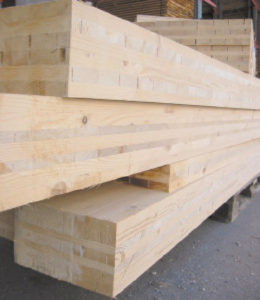A key element to reducing carbon footprint uses wood-based products to sequester carbon out of the atmosphere. A growing forest in Maine absorbs 1.4 tons of carbon from the atmosphere for every ton of wood produced. We love that equation at Katahdin Cedar Log Homes! In addition to construction from sustainable Northern White Cedar, we’ve also been exploring other methods and technologies to reduce carbon footprint in construction. Cross laminated beams are one way to continue carbon footprint reduction in larger homes where spans exceed 20 feet.
 Twenty-foot Limit Dictates Truss Placement
Twenty-foot Limit Dictates Truss Placement
In a recent article, Katahdin’s Tyson Weeks noted that in roof system design, there’s a 20-foot limit to spans, which dictates where trusses are placed to properly support the roof system. In cases where spans exceed 20 feet, cross laminated timber beams may be employed. This is a relatively new shift away from the use of steel for large spans in construction. Cross laminated timber beams offer several benefits:
- Lighter weight than steel
- Carbon reduction when compared with high carbon production steel beams
- Supports forest products industries
Plans in Maine for Cross Laminated Beam Production
Cross laminated beam production is being planned for an abandoned Lincoln, Me., paper mill site purchased in January 2020 by a North Carolina company, LignaTerra Global. The new 300,000-square-foot plant will occupy an open space on the site of the former Lincoln Paper & Tissue Mill, according to news reports in the Bangor Daily News. The company’s choice of the site was based on the nearby availability of large timber stands and demand for building products in New England. The plant will also provide a boost to the local Maine economy by employing 100 people.
Planning for Oversized Spans
If your dream Katahdin Cedar Log Home has large open concept areas, be sure to inquire about pricing in cross laminated wood beams for lightweight strength and excellent carbon reduction in your overall structure.
